
 |
If you really want to stir up an argument around little old Italian Grannies, bring up the subject of the proper way to prepare “Ragu Alla Bolognese”. Make sure to bring a crash helmet to that debate or at least identify a good hiding spot before throwing it out there for “discussion”. You’ll need a safe spectator spot as you watch the fur fly.
There are as many ways to prepare this sauce as there are grains of sand on the beach. And according to little old Italian Grammas, there is only one true grain of sand, and the one true path. The rest are imposters!
Every detail, from what kind of fat, how to render it, what kind of meats to use and in what proportions, the use of garlic, just what exactly which vegga-ta-bulls are used in the “Mirepoix”, the rendering of the meat mixtures, the use of tomatoes, what kind of spices, what kind of liquids to use, and more importantly the order of specific tasks and the amount of time required to get to the end product are hotly debated upon foodies around the world.
YOU EAT WHAT I COOK YOU’s recipes are Poppa Nick’s versions of classic dishes, but before they are committed to video and recipe cards, a lot of research happens behind the scenes to assess how they relate to the history of the dish, and also the general consensus of the most historically accurate ways to prepare them.
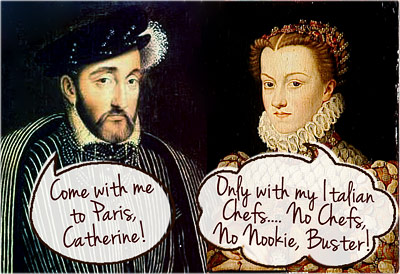 |
| King Henri II of France & Catherine De Medici of Florence |
Actually, it was King Henry II of France, and Catherine De Medici of Florence about a century earlier, but the general idea is the same. When in Primo’s kitchen, it’s best not to contradict him. The magic trick of history happens when he’s “in the moment” of zen concentration, and I try not to do anything to throw him off track.
When stories are traded in the kitchen and around the family table, we never let dry, yeastless factual knowledge get in the way of a good story. And although Primo’s versions of actual history might be wildly inaccurate, his recipes are not. The real history, is in the food. As far as his personal version of “Ragu Alla Bolognese” is concerned, he’s pretty spot on. It is a perfect marriage of Italian and French culinary techniques and styles that dates back hundreds of years.
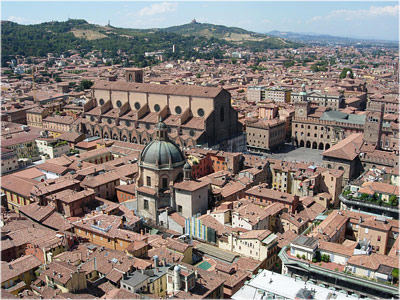 |
| Bologna "The Cradle of Italian Kooking", according to Primo. |
Primo has never seen the oldest published recipe, or the “official” recipe of the Accademia Italiana della Cucina. This is just the way he learned how to prepare it, with his own added spin thrown in for good measure.
So if you think that Bolognese Sauce is a bunch of browned ground beef with a jar of Ragu Spaghetti Sauce thrown in it, check out this version. His grain of sand, arrived at through oral traditions and heritage passed down through many generations, is truer to the five hundred year rendition of Bolognese Sauce than most of the modern recipes out there.
Is your helmet strapped on? Good. Let’s get cooking and let the debate begin... or as Primo says: “Let’s Get Lost In The Sauce Of History!”
Ingredients
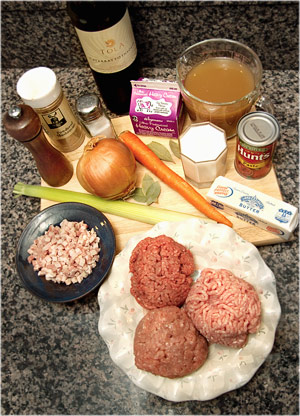 Here’s what you’ll need for one pound of Tagliatelle Pasta, or four very healthy servings:
Here’s what you’ll need for one pound of Tagliatelle Pasta, or four very healthy servings:
¼ pound of Pancetta, Bacon, or Ham.
½ pound ground Veal
½ pound ground Pork
1 pound lean ground Beef
One medium sized Onion, minced
One good sized Carrot, minced
One good sized Celery rib, minced
Approximately 5 Tablespoons of Butter
1 Cup of Dry White Wine
1- 1 ½ tablespoons of Tomato Paste
1 Cup Whole Milk
Approximately 12 cups of Beef Broth (Enough for four reduction cycles)
Fresh Ground Pepper
Salt (to taste and if needed)
Mushroom Powder: or Ground, Dried, Porcini Mushrooms
4-6 Bay Leaves
A few splashes of Heavy Cream
Finely Ground Parmigiano Reggiano Cheese (accept NO SUBSTITUTES!)
1 pound of Tagliatelle Pasta
The recipe
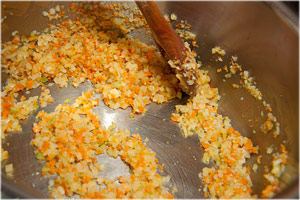 Step #1 “Butter Up and Sweat”
Step #1 “Butter Up and Sweat”
Melt butter in the bottom of a large sauce pan. Add the “Mirepoix” (minced onion, carrot, and celery) and sautee over medium heat. The object is to break the vegga-ta-bulls down and sweat them, not to brown them.
Step #2: “Mixxa Da Meat, and Brown it Up
- First, mix the Ground Pork, Veal, and Beef in a separate bowl, getting it staged for the browning step.
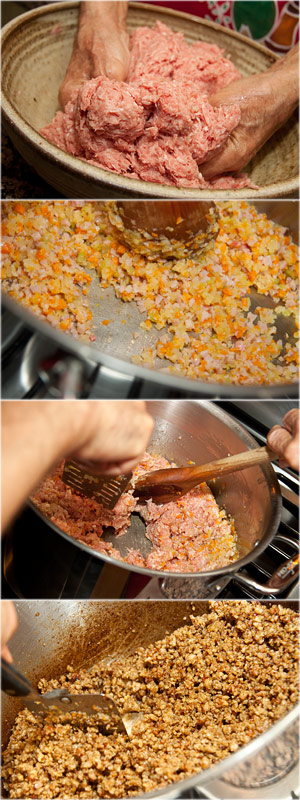 Add minced bacon, pancetta or ham to the now sweated mirepoix, and render the fat out of it over a medium heat.
Add minced bacon, pancetta or ham to the now sweated mirepoix, and render the fat out of it over a medium heat.- Add your meat mixture to the pot.
A note on “browning”... some folks sear the meat, others do not. Primo does, because he believes the brown bits that stick to the pot during this process is where all the real flavor resides, and it just looks more appetizing than boiled meat. Allow the meat to rest in the pot; not nudge it too much. Let any of the water in the vegga-ta-bulls evaporate, lifting the layer of meat every once in awhile to check for a brown color. When you have achieved that color, flip everything over with a spatula and break it all up into “crumbles”, continuing the browning process. This should take about 30 - 40 minutes over a medium heat. DOn’t rush this by jacking up the heat. Good things come to those who wait patiently.
When the meat starts to “snap, crackle and pop”, you’re ready for the next step.
Step #3 “Let’s get Juicy” or Adding the first stage of liquids
- Jack the heat to “High”: Pour in the wine, deglazing the pan while allowing the alcohol to burn off. Check with your nose to smell if you have it right. It shouldn’t “sting” but just smell beautiful. The meat should soak up the wine pretty quickly.
- Dillute the tomato paste in a cup with a little broth, and add to the pot. Let that mixture caramelize a little bit in the center of the pan before mixing it up with the meat.
- Add approximately two cups of beef broth, and reduce the heat to a low simmer. Really low!
Step # 4 “Spice is The Variety Of Life!”
- Add a good “lid” of fresh ground pepper on top of your sauce.
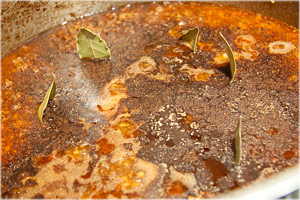 Sprinkle a good coating of dried, ground mushroom powder as well. This is a key ingredient!
Sprinkle a good coating of dried, ground mushroom powder as well. This is a key ingredient!- Add Bay leaves
Why no salt? It depends on the salt content of your broth. If you are using a salty broth, after four reductions, you have to taste for salt content right before serving. Salt can always be added, but never subtracted.
Step #5 “Milking It”
Stir in your Milk. It should now start to look like a traditional Bolognese Ragu at this point. Keep trying to scrape the brown bits on the sides of the pan to release those “flavor-noids” into the body of the sauce.
Step #6 “The Waiting Game”
To truly bring out the desired flavors, you have to play the patient waiting game of “reduce and re-hydrate”. Each reduction cycle may take anywhere from ½ an hour to an hour. As the sauce starts to dry out, re-hydrate it with another 2 cups or so of broth, water, or a combination of the two depending on how salty your broth is.
The slow simmering cooking process is what transforms this sauce from an Italian Sloppy Joe mix into something really special. The longer the cooking time, the bigger the flavors and the more impactful they become. Primo goes through four reduction cycles, but I find that two or three are sufficient. Plan on at least two hours of cooking time.
Step #7 “Finalization”
- Cook the pasta to an “Al Dente” consistency, in liberally salted, boiling water. Drain, and re-introduce back into the pasta pot. Add a little butter to coat each eggy strand of this wonderful pasta, tossing well.
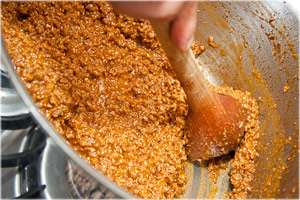 Add a little heavy cream to the Bolognese Sauce, and stir. It will radically change the color of your sauce, and its consistency, so use a light hand. Again, adding is no problem, but subtracting is kind of difficult.
Add a little heavy cream to the Bolognese Sauce, and stir. It will radically change the color of your sauce, and its consistency, so use a light hand. Again, adding is no problem, but subtracting is kind of difficult.- Taste for salt and final tweaking. It may need it. It may not. Let your taste buds be your guide.
- Add some sauce to the pasta, and over a medium heat, infuse the pasta with the sauce, tossing constantly. Turn off the heat before plating.
- Plate a serving, ladling a nice amount of sauce over the pasta. Sprinkle a good amount of Parmigiano Reggiano Cheese (The “Snow on the Mountain Top”) and serve. The Yummiosity has officially been unleashed.
This dish, and this sauce, is not a quickie in the parking lot. It’s a labor intensive magnum opus and a testament of true love from the chef; shared with the people he or she is preparing it for.
Tagliatelle Alla Bolognese is special treat in our house, and upon mastering it, it will be a consider a special treat in your home as well. Primo’s gift to you and your loved ones.
Mangia Bene!
[Watch the Video Tutorial for "Rossi's Tagliatelle Alla Bolognese"]
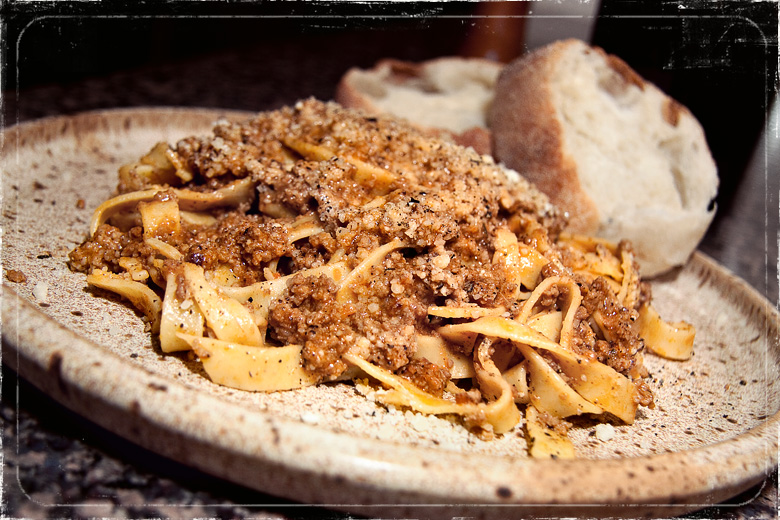
|
| Let's Get Lost In The Sauce Of History ~Poppa “Primo” Nick Rossi |